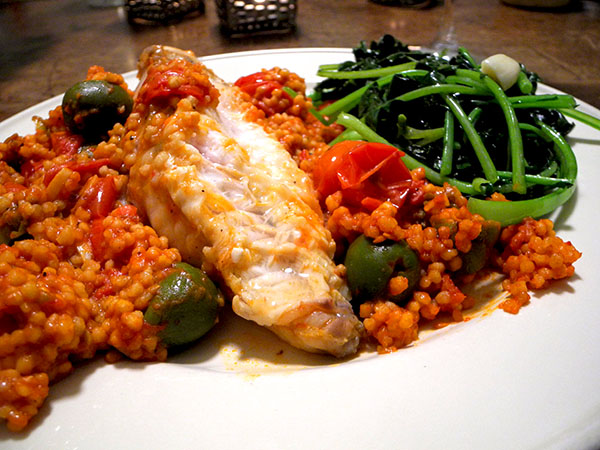
I could have put this meal together even more quickly (30 minutes start to finish) than I did, if only I’d remembered ahead of time that I was supposed to pit the olives before I tossed them into the mix of garlic, chilis, and tomatoes.
Incidentally, it’s a fantastic recipe, but for years I’ve been baffled by the fact that I could find no mention of it on line, anything even similar to it. In fact, if you do a Google image search for ‘inguazato’, 99.9% of the pictures that pop up are from my own food blog, and most aren’t even related to this dish. Tonight however, I tried searching under ‘coda di rospo couscous‘ (monkfish couscous), and I immediately came up with several sites, including this one. Now I can relax, but I also have to investigate further.
- two 9-ounce monkfish tails from Pura Vida Seafood, prepared using a David Pasternak recipe, but reducing the proportions, using two thirds of a cup of Tunisian M’hamsa Couscous and Portuguese olive oil, both from Whole Foods in Chelsea, sliced Rocambole garlic from Keith’s Farm, one and a half 400-gram cans of really good Afeltra canned pomodorini from Eataly Flatiron and several kinds of cracked green olives, from Buon Italia, Eataly Flatiron, and the Chelsea Whole Foods Market, all of which I happened to have on hand (ideally, they would be large green Sicilian olives), and 2 small whole dried peperoncino Calabresi secchi from Buon Italia
- two cavolo nero rooted hydroponic plants from Stokes Farm, wilted briefly inside a medium vintage tin-lined copper pot in a tablespoon or so of olive oil in which one Keith’s Farm Rocambole garlic clove had first been heated, the greens seasoned with sea salt and freshly-ground black pepper, drizzled with a little more oil
- the wine was a California (Carneros) white, La Tapatia Chardonnay Carneros 2016, from Naked Wines
- the music was from the remaining scenes or ‘Der Rosenkavalier‘, the opera which we had begun to listen to during dinner the night before